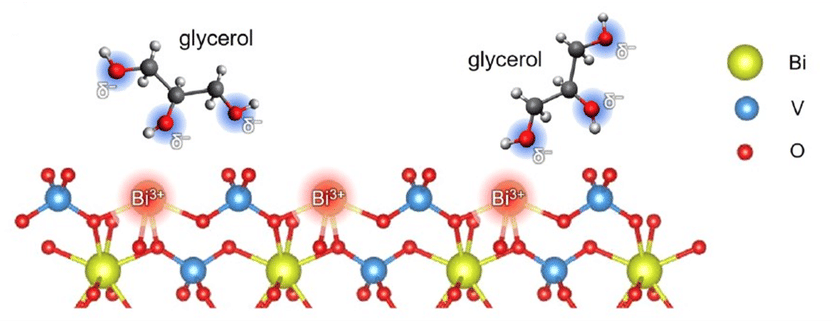From waste to value: The right electrolytes can enhance glycerol oxidation
"Our research could help to convert biomass by-products into valuable chemicals more efficiently"
When biomass is converted into biodiesel, huge amounts of glycerol are produced as a by-product. So far, however, this by-product has been little utilised, even though it could be processed into more valuable chemicals through Oxidation in photoelectrochemical reactors. The reason for this: low efficiency and selectivity. A team led by Dr Marco Favaro from the Institute for Solar Fuels at HZB has now investigated the influence of electrolytes on the efficiency of the glycerol oxidation reaction. The results can help to develop more efficient and environmentally friendly production processes.

The glycerol’s hydroxyl groups are attracted to the Bi3+ ions on the surface of the BiVO4 photoanode. The electrolyte plays a decisive role in mediating these interactions.
© HZB
In 2023, around 16 billion litres of biodiesel and HVO diesel were produced in the European Union, based on maize, rapeseed, or partially on waste materials from agricultural production. A by-product of biodiesel production is glycerol, which can be used as a building block for the production of valuable chemicals such as dihydroxyacetone, formic acid, glyceraldehyde and glycolaldehyde via a glycerol oxidation reaction (GOR). Glycerol can be oxidised electrochemically in (photo)electrochemical (PEC) reactors, which are currently being developed in particular for the production of green hydrogen. However, this path in PEC-plants is still hardly exploited at present, even though it could significantly increase the economic efficiency of the PEC Power-to-X process, since the oxidation of glycerol requires a much lesser energy input than hydrogen production through water splitting, but at the same time produces more valuable chemicals.
Examining the influence of different electrolytes
Many studies have already investigated the role of photocatalysts in PEC electrolyzers, while the role of the electrolyte had not yet been systematically analysed. A team led by Dr Marco Favaro at the Institute for Solar Fuels has now unveiled the influence of electrolyte composition on the efficiency and stability of the glycerol oxidation.
They used a PEC cell with photoanodes made of nanoporous bismuth vanadate (BiVO4). They tested acidic electrolytes (pH = 2) with various cations and anions, including sodium nitrate (NaNO3), sodium perchlorate (NaClO4), sodium sulphate (Na2SO4), potassium sulphate (K2SO4) and potassium phosphate (KPi). "Our results showed that BiVO4 photoanodes perform best in NaNO3 and outperform the commonly used Na2SO4 in terms of photocurrent, stability, and production rates of high-quality glycerol oxidation reaction products," summarises Favaro.
Sodium nitrate performs best
The team also investigated the reasons for this difference in performance: their hypothesis is that the size of the ions, their different salting in/out capabilities (Hofmeister series), and their different pH buffering capacity play a role. "The composition of the electrolyte has a surprising clear effect on the glycerol oxidation efficiency, and we were able to observe this trend in both bismuth vanadate and polycrystalline platinum anodes," says PhD student Heejung Kong. This supports the assumption that these findings could generally apply to different materials and processes.
The choice of electrolyte is therefore of great importance for the efficiency and stability of glycerol oxidation. "Our research could help to convert biomass by-products into valuable chemicals more efficiently and to produce valuable chemicals from waste materials while minimising the impact on the environment," says Favaro.
Original publication
Other news from the department science
Most read news
More news from our other portals
See the theme worlds for related content
Topic World Battery Technology
The topic world Battery Technology combines relevant knowledge in a unique way. Here you will find everything about suppliers and their products, webinars, white papers, catalogs and brochures.

Topic World Battery Technology
The topic world Battery Technology combines relevant knowledge in a unique way. Here you will find everything about suppliers and their products, webinars, white papers, catalogs and brochures.





























































